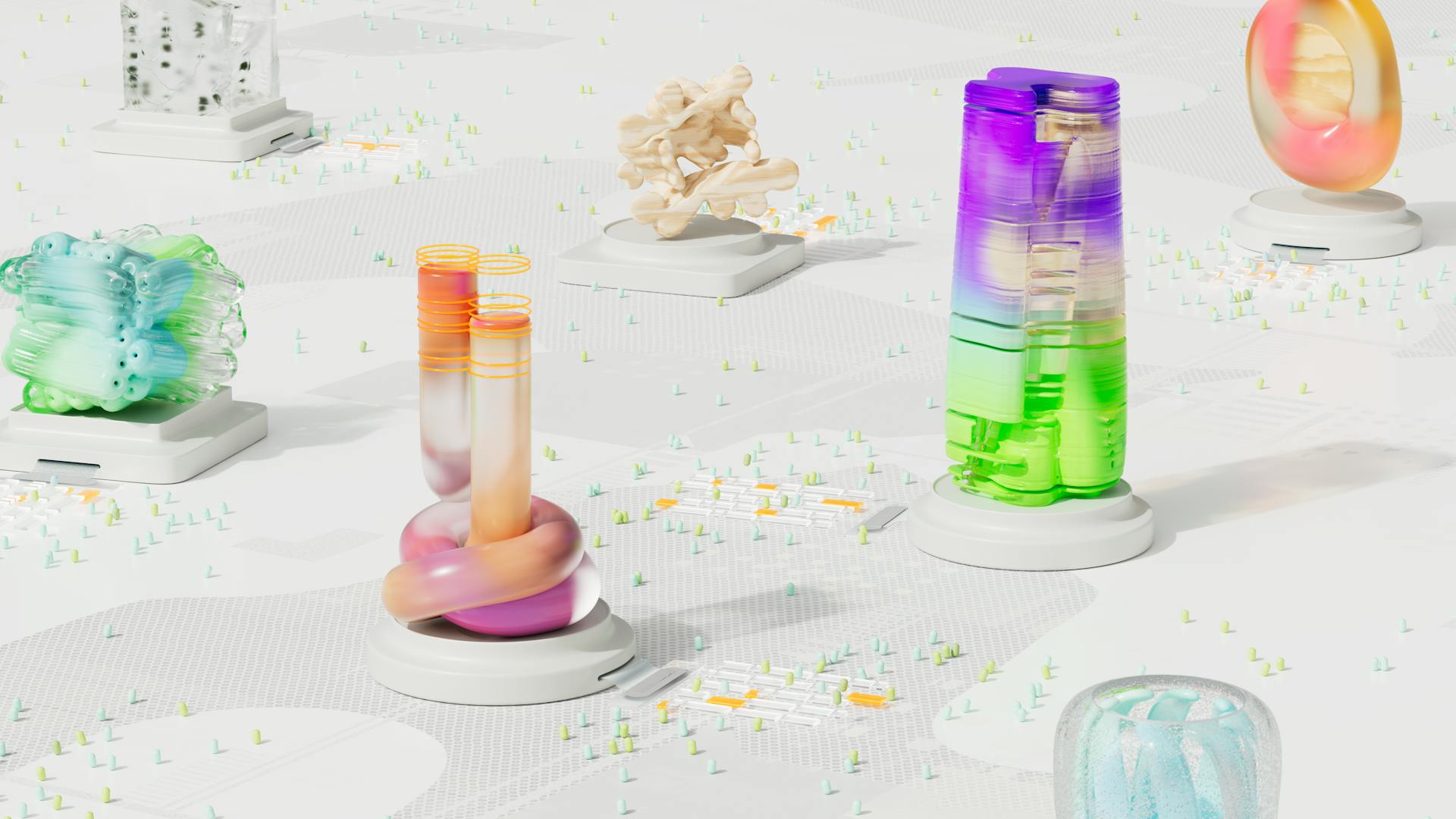
The process of bringing a software idea to life is a complex and fascinating journey. It begins with conceptualization, where the development team defines the problem, identifies the target audience, and outlines the key features and functionalities of the software.
A well-designed user interface (UI) and user experience (UX) are crucial for a software's success, as seen in the example of a popular e-commerce platform. The platform's UI is intuitive, making it easy for users to navigate and find what they need.
Effective communication among team members is vital throughout the development process. This is evident in the example of an agile development team that uses regular sprint meetings to discuss progress and address any challenges that arise.
A robust software architecture is essential for scalability and maintainability, as demonstrated by a cloud-based storage service that uses a microservices architecture to handle high traffic and user data securely.
For more insights, see: No Code Application Development Platform
Software Design Principles
Software design principles are essential for creating a well-structured and maintainable software system. A good designer should consider alternative approaches, judging each based on the requirements of the problem, the resources available to do the job.
To ensure a design is traceable to the analysis model, it's necessary to have a means for tracking how requirements have been satisfied by the design model. This helps identify any gaps or inconsistencies in the design.
A design should not reinvent the wheel, as systems are constructed using a set of design patterns that have likely been encountered before. These patterns should always be chosen as an alternative to reinvention, saving time and resources.
Here are some key principles of good software design:
- Modularity: Dividing a large software project into smaller portions/modules to make it scalable and maintainable.
- Coupling: Minimizing the extent of interdependence between software modules to make changes easier.
- Abstraction: Identifying essential behavior by separating it from its implementation and removing irrelevant details.
- Anticipation of Change: Building a design that can accommodate and adjust to change comfortably.
- Simplicity: Each task having its own module, which can be utilized and modified independently.
- Sufficiency and Completeness: Ensuring the software meets the established requirements and is adequately built.
Principles
Software design principles are the foundation of creating a well-structured and maintainable software system. A good software design should exhibit uniformity and integration, with rules of style and format defined for the design team before design work begins.
Modularity is a key principle of good software design, dividing a large software project into smaller portions or modules. This makes it easier to test each component and integrate new features. Low coupling is also a feature of good design, where changes can be made in each module individually without affecting the other modules.
A good software design should be structured to accommodate change, with the ability to adjust to changing requirements. It should also be assessed for quality as it is being created, not after the fact. This can be achieved by using design concepts and measures that assist the designer in evaluating quality throughout the development process.
There are several types of cohesion, which define the degree of intra-dependability within elements of a module. Functional cohesion is considered the highest degree of cohesion, where elements of a module are grouped because they all contribute to a single well-defined function. This type of cohesion is highly expected and can also be reused.
A software architect or solutions architect can help capture your ideas and translate them into a software solution that your users will love. They can ensure that the software design is well-structured and maintainable, with a focus on modularity, low coupling, and functional cohesion.
Here are the different levels of coupling, which define the level of inter-dependability among modules of a program:
Ideally, no coupling is considered the best, but it's not always possible to achieve this. By understanding the different levels of coupling, you can design a software system that is more maintainable and easier to modify.
Models
In software design, having the right models in place can make all the difference. A model is essentially a framework or structure that guides the design process.
There are several software design models to choose from, including the Waterfall Model, RAD Model, Spiral Model, V-model, Incremental Model, Agile Model, Iterative Model, Big-Bang Model, and Prototype Model.
A good designer should consider alternative approaches, judging each based on the requirements of the problem, the resources available to do the job. This is especially true when it comes to choosing a software design model.
Here are some of the most common software design models:
By understanding the different software design models, you can choose the one that best fits your needs and goals.
Reliability Models
Reliability Models are crucial in software design to ensure that applications can withstand stress and malicious users. Software Reliability Models include various methods to predict and measure reliability.
The Jelinski & Moranda Model is one such approach that models the failure rate of software over time. Another model, the Basic Execution Time Model, focuses on the execution time of software.
The Goel-Okumoto (GO) Model and Musa-Okumoto Logarithmic Model are also used to predict software reliability. These models help developers understand how to improve the reliability of their software.
Here are some Software Reliability Models:
- Software Reliability Models
- Jelinski & Moranda Model
- Basic Execution Time Model
- Goel-Okumoto (GO) Model
- Musa-Okumoto Logarithmic Model
Understanding Project Requirements
Understanding project requirements is the foundation of software design and development. It's essential to identify your users' pain points and difficulties to create a software design that addresses their needs.
Before starting to design software, you need to understand the project requirements. This involves defining a design goal for yourself and identifying the issues you need to address.
Requirements analysis is a crucial part of software development that helps break down complex problems into smaller, manageable ones. It's a process that involves listing specifications used in software engineering.
A software requirement can be broken down into several components, including software requirement specifications, requirements analysis, data flow diagrams, data dictionaries, and entity-relationship diagrams.
Here are some key elements to consider when understanding project requirements:
- Software Requirement Specifications
- Requirements Analysis
- Data Flow Diagrams
- Data Dictionaries
- Entity-Relationship Diagram
By understanding project requirements, you can create a software design that meets the needs of your users and solves the problems you've identified. This is the first step towards developing software that is effective and user-friendly.
Software Development Process
The software development process is a crucial step in creating reliable and robust software. It's an iterative cycle that involves gathering ideas and end goals, processing the information, proposing a solution, receiving feedback, and refining the design.
This cycle may happen once or several times until you arrive at the final design that works for you. The common steps for a software design process typically include understanding your business and the context of the software, understanding what is driving the need for software, and understanding the goals and desired end result that the software will bring.
The software development process also involves collaboration and feedback, which is essential for creating a great software solution. At SOLTECH, projects begin with Solution Design, which is led by a solution architect with support from other design team members. The solution design team is composed of experienced resources that assist with evaluating your business needs, software ideas, technical objectives, and budget targets.
Broaden your view: Creating Ram Drives
Here are the common steps for a software design process:
- Understanding your business and the context of the software
- Understanding what is driving the need for software
- Understanding the goals and desired end result that the software will bring
- Understanding the users, how they will be using the software, their needs, and their limitations
- Understanding the technology experience and preferences of your company
- Collaborating on the future solution using a whiteboard and real-time discussions and diagramming
- Proposing a solution using visual tools such as wireframes, storyboards, mockups, and diagrams.
- Getting feedback on the solution
- Collaborating on modifying the proposed solution with whiteboarding and real-time discussions
- Finalizing the design
- Getting approval
- Creating a detailed document of the final design that can guide development
The Solution Process
The Solution Design Process is the foundation of software development, and it's led by a solution architect with support from other design team members.
At SOLTECH, projects begin with Solution Design, which is led by a solution architect with support from other design team members such as user experience architects, application architects, and cloud architects.
The solution design team is composed of experienced resources that assist with evaluating your business needs, software ideas, technical objectives, and budget targets.
The design process will then translate your vision into a defined and actionable solution that includes technology choices, user experience design, software architecture, implementation plans, and budget forecasts.
The software design process typically includes several stages, starting with Understanding project requirements, Research and Analysis, Design, Prototyping, and Evaluation.
Here are the key stages of the software design process:
The software design process is iterative, meaning it involves a cycle of gathering ideas, processing information, proposing a solution, receiving feedback, and refining the design.
The design process requires collaboration and feedback from stakeholders, including users, developers, and project managers.
The solution design team will help you capture your ideas and translate them into a software solution that your users will love and deliver what your business needs long term.
By following the software design process, you can ensure that your software is designed and built to meet the needs of your users and your business.
You might like: Ai Software for Business
Maintenance
Maintenance is a crucial aspect of the software development process. It's not just about fixing bugs, but also about ensuring the software remains stable, secure, and efficient over time.
Software maintenance is necessary due to the causes of software maintenance problems, which include changes in user requirements, new technologies, and environmental factors.
These changes can lead to software maintenance problems, which can be costly and time-consuming to resolve.
Software maintenance cost factors include the cost of labor, materials, and equipment, as well as the opportunity cost of diverting resources away from new development projects.
Curious to learn more? Check out: Android 12 New Features
Here are some key software maintenance cost factors to consider:
- Cost of labor: This includes the salaries and benefits of software maintenance personnel.
- Materials and equipment: This includes the cost of hardware, software, and other resources needed to maintain the software.
- Opportunity cost: This includes the cost of diverting resources away from new development projects.
Software Development Tools and Techniques
In software design, having the right tools can make all the difference. Draw.io is a great tool for creating diagrams in Confluence and Jira, allowing you to easily create flowcharts, process diagrams, and ER diagrams.
To plan, track, release, and report your work, Jira is a highly efficient software development tool. It also allows you to choose a workflow or make your own workflow.
For designers, Mockflow is a web-based wireframe tool that provides an extensive library of mock components, icons, stickers, and more. Sketch is a vector graphic editor for MAC users, ideal for user interface, mobile, web, and icon design.
Here are the top 6 most effective and commonly used tools for creating software design:
- Draw.io
- Jira
- Mockflow
- Sketch
- Marvel
- Zeplin
These tools can help you streamline your design process and collaborate with your team more effectively. Marvel provides intuitive designing and prototyping tools that help software designers wireframe, design, and prototype fast.
Readers also liked: Informatic Tools
What Tools Are Used for Creating?
When creating software, you'll want to use the right tools to get the job done efficiently. Draw.io is a great tool for creating diagrams in Confluence and Jira, allowing you to create flowcharts, process diagrams, and ER diagrams with ease.
Draw.io also lets you design your own unique shape libraries. Jira, on the other hand, is a highly efficient software development tool used to plan, track, release, and report your work.
Jira allows you to choose a workflow or make your own workflow, and it easily integrates with the tools you already use. Mockflow is a web-based wireframe tool for designers to plan, build, and share their work.
Mockflow is cloud-based and provides an extensive library of mock components, icons, stickers, and more. Sketch is a vector graphic editor for MAC users, used for user interface, mobile, web, and icon design.
Sketch is a powerful tool for designers who work on MAC. Marvel provides intuitive designing and prototyping tools that help software designers wireframe, design, and prototype fast. Zeplin provides a platform for designers to share, organize, and collaborate on their designs.
Here are the top 6 most effective and commonly used tools for creating software design, in a list for easy reference:
- Draw.io
- Jira
- Mockflow
- Sketch
- Marvel
- Zeplin
Technology Selection
Selecting the right technology is crucial in software development. You have many options to choose from, including licensed and open source software.
Both your business and software requirements will impact your technology selection. This is why a solution architecture team is essential to make wise technology decisions.
Your business needs should be the top priority when selecting technology. The technology you choose should support your business both now and in the future.
You want to choose technology that meets your needs, not the other way around. This means asking the right questions to ensure the technology is a good fit.
The job of a solution architecture team is to make technology decisions that support your business. They help ensure the technology is aligned with your business goals.
Recommended read: Ai Architecture Software
Software Quality and Testing
Software quality and testing are crucial aspects of software design and development. Software design is a mechanism to transform user requirements into a suitable form, making it easier to implement using a programming language.
The software design phase is the first step in the Software Design Life Cycle (SDLC), shifting the focus from the problem domain to the solution domain. In this phase, we consider the system as a set of components or modules with clearly defined behaviors and boundaries.
Software design involves representing the client's requirements, as described in the Software Requirement Specification (SRS) document, into a form that's easily implementable using a programming language. This process helps programmers in coding and implementation.
Design verification is essential to ensure that the output of the design phase is accurate and of high quality. A good design review is important for good software design, accuracy, and quality. By structured verification approach, reviewers can detect defects that might be caused by overlooking some conditions.
Software testing is a critical aspect of software quality, and it's essential to detect defects early in the development process. Software metrics, such as Halstead's software metrics and functional point (FP) analysis, can help measure the complexity and quality of the software.
Here are some common software metrics:
- Halstead's software metrics
- Functional Point (FP) Analysis
- Extended Function Point (EFP) Metrics
- Data Structure Metrics
- Information Flow Metrics
- Cyclomatic Complexity
Software reliability is another critical aspect of software quality, and it's essential to ensure that the software is reliable and fault-tolerant. Software reliability models, such as the Jelinski & Moranda model and the Goel-Okumoto (GO) model, can help measure and predict software reliability.
Frequently Asked Questions
What is the difference between a software developer and a software designer?
A software designer creates concepts to address problems, while a software developer brings those concepts to life by building actual applications. The developer turns ideas into reality, executing the designer's vision.
Featured Images: pexels.com


